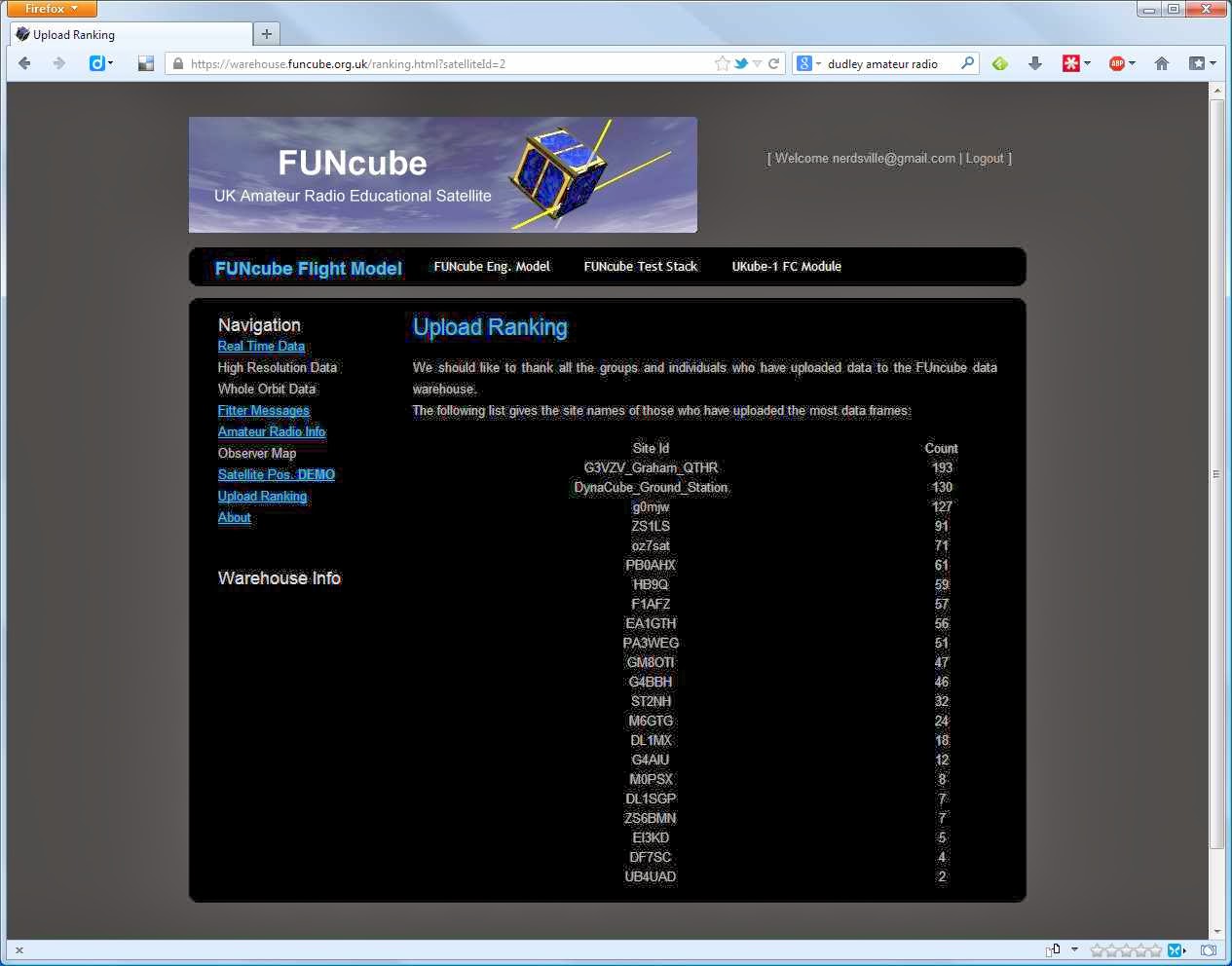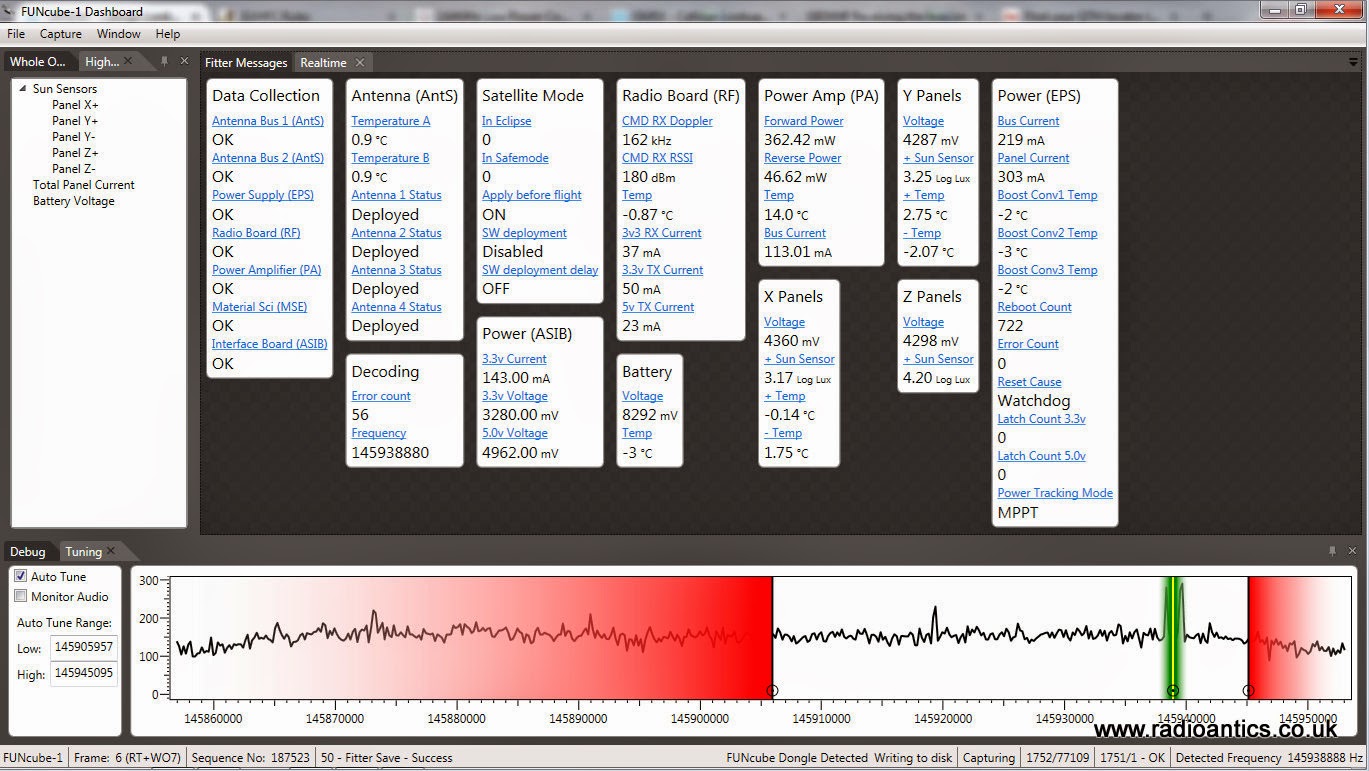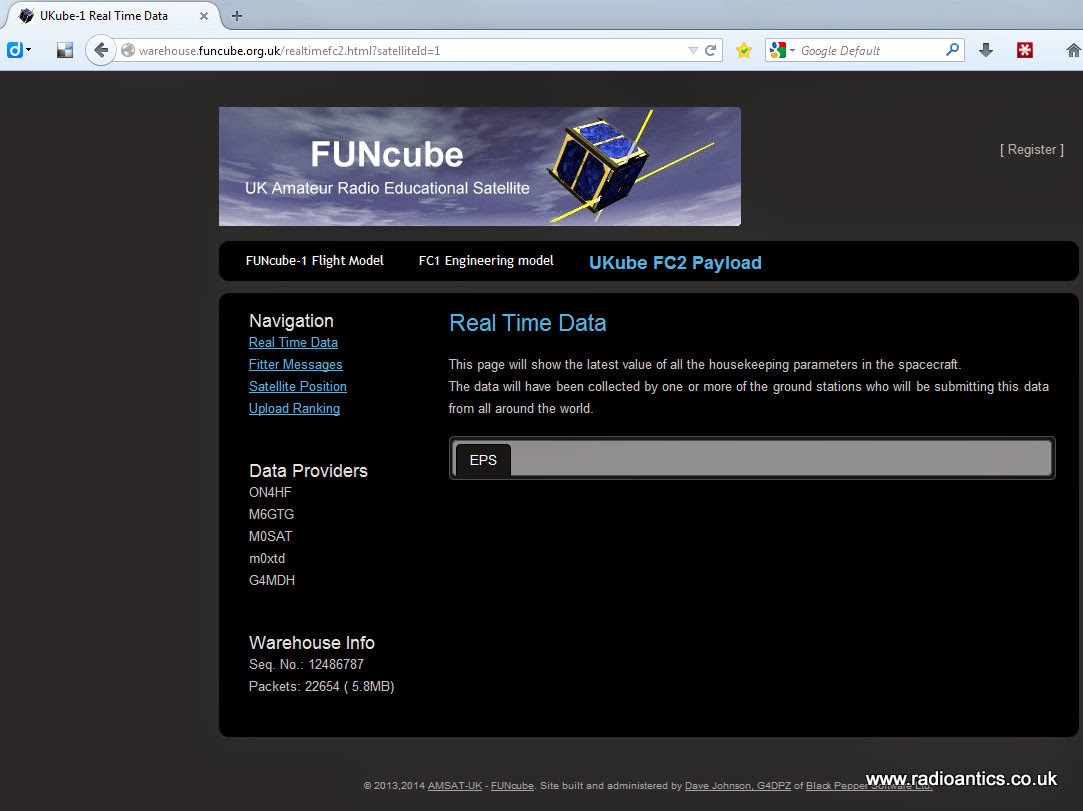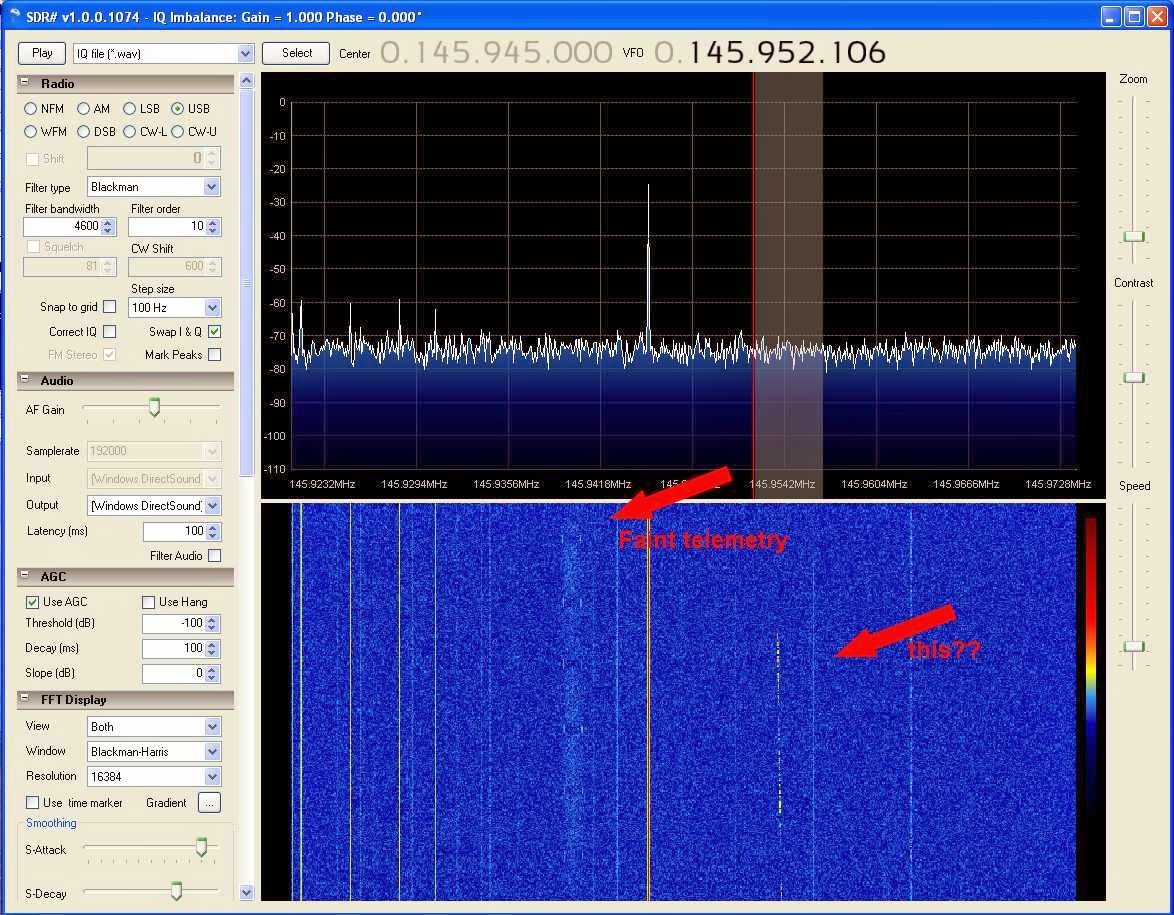Posts Tagged ‘FUNcube’
 FUNCube-1 & FUNCube-2 Decoding Update
FUNCube-1 & FUNCube-2 Decoding Update
Amateur radio has so many different things to try and over the last year I have found myself jumping around having a dabble at new things. Doing this and time being scarce has inevitably impacted the HAB payload and other Arduino projects. I have also neglected some of my previous satellite monitoring activities.
I had been regularly decoding the FUNCube-1 (AO-73) telemetry and uploading packets to the data warehouse (see earlier posts). To do this I had been using a discone in the loft and a FUNCube Dongle on the ageing main computer in the house.
This computer was on 24/7 but I couldn't leave the FUNCube dashboard running continually as the processor load would cause the noisy fans to kick in, besides for most of the day there wasn't a receivable pass. So I would just start up the dashboard when needed which meant remotely logging in from work. Due to an increasingly busy work load I would often forget or be unable to start it up and have got out of the habit. I therefore missed many opportunities to climb up the uploading ranking chart (it is really for the science honest!)
Of late there have been a large number of new satellites launched including the UKube-1 and the QB50 satellites which have modules and transponders as part of the FUNCube project.
Catching up with news after the holiday to Skye I noticed the announcement that an enhanced version of the FUNCube decoder dashboard has been released promising improved performance. The dashboard will also capture and upload (but not display) the FUNCube-2 telemetry transmitted from UKube-1
Looking at the FC1 upload ranking list I saw I had dropped down significantly and decided it wasn't acceptable!
As part of my antenna upgrade I have put up the X-50 dual-band collinear on the top of the pole feed with nice low loss RG213. This is currently connected to the FUNCube Dongle Pro+ dongle on the shack laptop, with the latest dashboard software installed.
It has been running 24/7 for the majority of the last week and has captured close to 2000 telemetry packets from FC1 a significant performance increase compared to my earlier set up, and I have now surpassed the 10,000 packet milestone (currently 11,626). I have also uploaded over 500 telemetry messages received from the FUNCube-2 on UKube-1. I have actually received more but a fault in the warehouse meant a lot were rejected due to a incorrect data field.
The FC2 subsystem on UKUBE-1 may not be enabled on every pass while the satellite is commissioned and the FUNCube team will be releasing an updated dashboard shortly for when it is operating full time.
At present both satellites are passing one after the other, with UKube-1 gradually gaining. So as FC1 goes LOS (loss of signal) UKube-1 rises elsewhere for AOS (acquisition of signal)
On one pass yesterday I thought I would capture some screen shots and show how I've got the dashboard set up for both payloads.
As already mentioned the existing dashboard can be used to receive both FUNCube-1 and 2, if using the FUNCube Dongle Pro+ by setting the central frequency to 145.905MHz and adjusting the upper and lower filter curtains both payloads can be received.
On the Orbitron prediction software you can see FC1 is overhead, with UKube-1 over the North pole.
The reception window on the dashboard is limited by moving the curtains. I have the lower one set at 145.906MHz just enough to filter out the centre SDR spike, the upper one is at 145.945MHz. The telemetry signal on FC1 is at 145.935MHz but due to the Doppler effect the received frequency will vary above and below this nominal value, 10kHz either size is sufficient to compensate.
If you were just interested in one satellite you would move the lower curtain to around 10kHz below the nominal download frequency. However since UKube-1 is on 145.918MHz the lower curtain is set to below this again to compensate for the Doppler shift.
The resulting receive window will allow both to be received. However this does risks problems should QRM occur in the pass band as the decoder can lock on to this, luckily the improved dashboard software discriminates between the signal and noise much better than previous versions.
The dashboard below is receiving the FUNCube-1 signal (click to enlarge)
The data is being uploaded and checking the real time display on the warehouse confirms this (my old callsign M6GTG) however you might not show up every single time and the FUNCube-1 Flight Model tab must be chosen as seen below.
As the pass finishes and UKube-1/FC2 comes overhead and due to the omni-directional X-50 I don't need to change anything.
The dashboard soon detects the new signal at the lower frequency and begins decoding.
The received payload ID is shown in the bottom right of the dashboard
Again the upload can be confirmed by viewing the real time data page on the warehouse by selecting the UKube-1 FC2 Payload tab. It should be noted that it seems FC2 is sometime sending spurious data elements in the telemetry which the warehouse is rejecting so some uploads may not be displayed.
It is really that simple.
 FUNCube-1 a thank you received from space!
FUNCube-1 a thank you received from space!
What seems to have been the issue is a reduced quality of received signal. Operators with higher gain, optimised antennas appear not to have seen problems. Why there has been such a fall off isn't clear, the power output of FUNCube-1 hasn't altered and appears not to be tumbling.
The FUNCube team have now released a new version of the Dashboard Software. Version 820 can be downloaded from http://funcube.org.uk/working-documents/funcube-telemetry-dashboard/ The major change in Version v820 centres on improved decoding routines which give better results, especially with weak signals at low elevations and simpler antennas.
I have been running this now for several days and can confirm it is much better, as promised low elevation passes now get successful decodes and night time passes when the telemetry is on low power get successful decodes something I wasn't getting before.
Now I have the shack sorted I have set up a dedicated receiver using the original FUNCube Dongle using the X-30 white stick collinear and this has been pulling in decodes nicely.
This morning I had surpassed the 2000 telemetry decodes milestone, as can be seen on the rankings page.
Another nice result over the weekend was seeing my callsign in one of the FITTER messages
Rx'd my callsign in the 'Thank You' Fitter messages from FUNCube-1 over the weekend, nice touch! pic.twitter.com/MvJt8p6tVUIt is a nice touch that the FUNCube-1 have started acknowledging the receivers, hopefully with the improved software there will be more participants.
— Andrew Garratt M6GTG (@nerdsville) February 3, 2014
The next stage for me? Well must sort out trying to have a QSO via FUNCube-1 and the other satellites..
 FUNCube Decode Issues
FUNCube Decode Issues
I also had a small write up in Tim Kirby's (G4VXE) VHF/UHF section of the February issue of Practical Wireless about my I-Cube1 reception which I have mentioned on here before.
I haven't progressed very far with my Arduino projects. There has been a set back in the plans to build and use an Ultimate3 QRSS kit. I had incorrectly assumed as it was a kit being sold commercially that it would satisfy my foundation conditions. However I have been advised that Foundation license holders may use radio equipment constructed using commercially available kits which satisfy IR 2028 which is all a bit vague and woolly, but I don't believe this particular kit does.
There is a simple solution, I will just have to take my intermediate assessment and exam at the first opportunity!
I have been doing a little WSPR spotting, getting some nice spots.
Over the Christmas/New Year period I have neglected the FUNCube-1(A073) satellite and was slipping down the telemetry upload rankings, sad I know!
Now I have got back the upstairs 'shack' I set up my original FUNCube Dongle on the laptop running the dashboard application continually to capture/decode the telemetry using the loft mounted discone. I took the opportunity to upgrade to the latest version 8.14 of the dashboard software, however something was amiss when checking the statistics I was only adding the odd frame here and there, sometimes not making a single decode during the high power daylight passes.
I switched back over to the newer FUNCube Dongle PRO+ running my main PC, which I had also updated to the version 8.14 dashboard and saw the same behaviour, rather than getting daylight decodes of 30+ frames I was just getting the odd 1 or 2.
My first thought it was an antenna or interference issue, but checking the SDR waterfall the signal is still very strong with little QRM. Suspecting a software issue introduced by the update I checked the FUNCube forum and found a thread which appeared to confirm my suspicions.
I have a number of discussions on twitter with various people including David Johnson (G4DPZ) an AMSAT-UK Committee Member and one of the developers of the FUNcube ground segment. David kindly performed an analysis of one of the passes yesterday where I managed just 2 frames, and from the results it does appear to be an issue at this end, rather than issue with the spacecraft.
I have uninstalled v8.14 and put back on an earlier version of the dashboard (v8.09) and thanks to a windows update last night have also performed a full reboot!
There was a good pass this morning at 62 degrees maximum elevation (to the east), followed by a lower pass at 22 degrees elevation (to the west so not so good) and it seems things have improved managing 68 and 17 frames respectively. So could this be an issue with the latest dashboard?
If anyone has suffered similar performance fall-off, or indeed not suffered any issues then please add some feedback to the FUNCube forum.
My copy of Radcom arrived but didn't have much time to read it..
| The culprit! ;-) |
 Mentioned in Practical Wireless! and some Christmas stress
Mentioned in Practical Wireless! and some Christmas stress
This has meant I have had to tackle some long put off home renovation projects. The first was to redecorate the bathroom and what should have been a simple paint job has snowballed into a major project and has sapped a lot of free time. Thankfully it is now all but done.
The second was to turn the third bedroom back into an actual bedroom rather than the study/computer room/indoor radio shack it had become. Again this involved more work than planned including dismantling and remodelling of a home-made desk and the removal of piles of collected radio/computer junk and books.
The upshot of all this work and de-cluttering is my outside workshop has turned into a bomb site! Most of the junk has been dumped in it and it is very untidy with tools scattered everywhere. I also had a minor catastrophe when trying to retreive a workmate when my beloved 2Meter YAGI, fell off its perch breaking off the reflector and a director! Thankfully Justin at InnovAntennas was able to sort me out some replacement boom insulators
With all this upheaval, combined with work pressures I have been unable to really do any radio or electronics for most of this month. Do I sound like the Grinch?
Despite this I have been able to capture the odd FUNCube-1(AO73) pass and have nearly reached 1000 telemetry packets.
It came as a pleasant surprise was finding out I was mentioned in the January issue of Practical Wireless magazine. Tim Kirby (G4VXE) reported on my ISS SSTV capture and APRS experiments. Tim the magazines VHF/UHF editor has his own blog and is someone I converse with on twitter (@G4VXE)
I realised I didn't blog my SSTV capture back in October, but did post it on twitter feed (@nerdsville)
Not sure what it is, but this SSTV image just received from the ISS with completely the wrong antenna! pic.twitter.com/5uka2aHfic
— Andrew Garratt M6GTG (@nerdsville) October 28, 2013 Here is a scan of my mention and the picture.. I can forgive Tim misspelling my name, it happens a lot! It also seems I might get mentioned in the February issue to following my ICube-1 reception report. |
| From Practical Wireless - January 2014 Issue |
 |
| From Practical Wireless - January 2014 Issue |
 FUN cubed
FUN cubed
I have just received my first telemetry from the FUNcube satellite, a.k.a. OSCAR 73. It was a piece of cake, one of the easiest things in ham radio I have done. What helped make it easy was that I was using a FUNcube Dongle Pro as the receiver (thanks, John!) . The FUNcube dashboard software supports it out of the box. No drivers to install or soundcards to configure. It was a piece of cake.The Dongle automatically tunes to the right frequency.
Of course, the whole project has been designed to be used by teachers with no previous experience of this kind of stuff. So you would expect it to be easy for a seasoned radio ham!
 |
| The FUNcube Dashboard software |
The whole thing went something like this:
- Download and install .NET Framework 4.0 from Microsoft.
- Download and install FUNcube Dashboard from http://data.funcube.org.uk/
- Register your call at the FUNcube data warehouse https://warehouse.funcube.org.uk/.
- Download, read and follow the instructions (PDF files) from the FUNcube site.
- Connect dual band colinear to FUNcube Dongle.
Sit back and wait for a pass.
I was not present when the satellite went over as I was downstairs having lunch.
There are no suitable passes over this location this evening or tonight so I will have to wait until tomorrow for another try. Unfortunately apart from an FT-817 and the dual band vertical I don’t have equipment that can operate 2m ans 70cm so I’ll have to leave tryi ng to work through the transponder to someone else.
 Did I make ICube-1’s first signal report?
Did I make ICube-1’s first signal report?
Well this morning saw the launch of the numerous satellites from the Dnepr rocket including Funcube-1, and this morning saw the first passes over the UK. Like many others I eagerly sat in front of my computer awaiting the chance to decode the telemetry. However I was doing it remotely using a VNC connection as I was in work...
Sure enough at 10:21 the pass started and a nice strong signal appeared on the waterfall and the FUNCube dashboard sprang to life. I managed 29 packets on the first pass!
 |
| The upload ranking at the FUNcube data warehouse |
However I noticed another CW signal further up the spectrum which seemed to be on the edge of the FUNCube transponder allocation (145.950MHz) I went to twitter and asked if FUNCube-1 was transmitting a CW beacon? Peter 2E0SQL thought it might be another satellite.
At start of earlier FUNCube-1 pass, what looks like CW on transponder downlink frequency? #funcube pic.twitter.com/yLvgzYzZRJ
— Andrew Garratt (@nerdsville) November 21, 2013
I had captured the pass as an IQ file, and set about trying to decode the CW. I had several attempt using fl-digi remotely but chasing a fast moving doppler on a laggy remote connection wasn't good but I seemed to repeatedly get ***ISTAN.
On the next pass the same thing happened, this time I got the word CUBESAT several times..
The signal had the same doppler shift as FUNCube-1 so was from the same launch constellation and a quick check and I spotted ICube-1 the first cubesat launched by Institute of Space Technology in Pakistan.. which was listed as broadcasting on 145.947MHz using AFSK.
It must be.. ***ISTAN... CUBESAT.... So I sent them a message on their Facebook page and they confirmed that at this stage of the mission they were indeed supposedly broadcasting a CW beacon and what I decoded was part of the message!
Khurram project manager of ICube-1 said "Thanx Andrew ... your message was a great relief for us"
and on their facebook page
First Signal has been received from ICUBE-1 in UK ... Alhamdulillah the ICUBE-1 mission is successful ... Congrats everyone. Satellite will pass over IST around 9:30 pm today
So it seems lowly M6GTG may have made the first signal report confirming Pakistan's first successful cubesat deployment!
I am grinning madly at the moment!
 Show Notes #084
Show Notes #084
Introduction:
- No music this time; just one hour jam-packed with LHS goodness!
Announcements:
- Remember to sign up for the following LHS services:
- The LHS SubReddit
- The LHS Mailing List
- The LHS Mobile app. Follow our updates via the mobile applications available for iPod, iPhone, iPad and Android devices.
- Be an LHS Ambassador! Please join our Ambassador program. The event calendar has expanded quite a bit and we need your help. These events are now world-wide, so we could use some help outside the US as well as all over the country from California to Maine.
- YFKtest: Yes, there really does seem to be a problem. It’s been confirmed by John, EI7IG, that the program does not log contacts for the ARRL Field Day contest. Other contests work fine. Russ plans on emailing the developer, DJ1YFK, with these observations.
- From the “Yes, It’s an Antenna” File: Multi-band HF dipole made from horse fencing.
- Pulling a Lunduke: Holding Source Code Hostage. Our hosts discuss this blog post by Tom Nardi about Bryan Lunduke’s recent move to open source his software. Bryan is one of the hosts of The Linux Action Show.
Topics:
- Software Defined Radio (SDR)
- A common topic Russ encountered at Dayton was about the available Linux options for software defined radios.
- GNU Radio Project
- Version 3.6.0 released in early May, 2012.
- Version 3.2.2 is in the Debian Sid repository.
- The latest version can be retrieved with git. (Install git with the command “apt-get install git”.) To download the software, issue the command “git clone git://gnuradio.org/gnuradio”.
- Build instructions are available for most of the major Linux distributions.
- SDR Hardware
- Ettus USRP series works with the GNU Radio Project software. There are various models ranging in price from $700 to $2000, depending on the frequency range and options. Various modules allow receive and/or transmit on bands from 30kHz to 5.9GHz. Unfortunately, power output appears to be just 50-200mW, depending on the bands provided by the transmitter daughter board chosen.
- Funcube Dongle costs £128 (~$200) and is a receiver only. The Funcube Dongle is a “radio receiver designed to allow anyone to try their hand at reception of satellites like FUNcube”. It covers 51.5MHz – 1.7GHz, less the region from 1.1GHz to 1.2GHz.
- Perseus SDR costs $1000 and is also receive-only. It receives 10kHz to 40MHz.
- SoftRock SDR is a kit available in various models from $20 to $90. Most are receive-only, but the Ensemble is a 1W HF transceiver. Some models are unavailable at the moment. The SoftRock RXTX Ensemble Transceiver Kit will allow you to build a 1W transceiver for one of the following bands or band groups: 160m, 80m/40m, 30m/20m/17m, or 15m/12m/10m.
- RTL-SDR Devices range in price from $20 to $200 and are receive-only. More on the RTL-SDR project in an upcoming episode.
Feedback:
- Stewart, VA3PID, wrote to say that Russ was the first person, possibly ever, to correctly place his Scottish accent at Hamvention. He also remarked (in reference to a discussion in episode 71) that Chirp has come a long way; it can now program his Yaesu FT-857D!
- Jonas recently re-discovered LHS and expressed his appreciation for the show. Thanks, Jonas!
- Stefano, IZ3NVR/KD2BGM, asks for more help getting so2sdr built on his Linux machine. Russ suggests installing the compiler with “apt-get install g++ build-essential”, installing Qt and several other packages as described in Episode 83, then try building the so2sdr program again.
- Lastly, David Dominicki left a mostly unintelligible comment in response to Episode 78. Um, thanks… we think.
Contact Info:
- Contact Richard at [email protected], Russ at [email protected], or both at the same time at [email protected].
- Listen to the live stream every other Tuesday at 8:00pm Central time. Check the LHS web site for dates.
- Leave us a voice mail at 1-909-LHS-SHOW (1-909-547-7469), or record an introduction to the podcast.
- Sign up for the LHS mailing list.
- Sign up for the MAGNetcon mailing list.
- LHS merchandise is available at the Merch link on Web site. Check out the Badgerwear or buy one of the other LHS-branded items at PrintFection.com/lhs or Cafe Press. Thanks!
- Thanks to Dave from Gamma Leonis for the theme music.
Music:
- None.























